82 F. high in the Twin Cities Monday.
72 F. high on May 26.
60 F. high on May 26, 2013.
May 26, 1930: Great Empire Builder Tornado. A direct hit derailed famous train in Norman County.

“…Yet it seems to me, that given the scientific evidence, and with the future of the planet at stake, anyone denying the existence of man-made climate change, is demonstrably not fit to be president.” – from an Op-Ed by former ABC News correspondent Barrie Dunsmore. Details below.

Cabin Combat
I admire people who are good with their hands, able to build and repair things with little effort.
I am not one of those people. I have trouble using a can opener.
For 20 years I was baffled why people would battle 2, 3, even 4 hour commutes to their cabins. “We have lakes in the metro!” It dawned on me that disconnecting from TV & WIFI, then reconnecting as a family up north, no distractions, was a tonic for the soul.
We’ve had a place on Pelican Lake for 11 years. In that time I’ve broken toes in a horrible mulching accident and had painful tetanus shots after stepping on rusty nails. Last year I almost cut off a finger laying down pavers. I should have bought a cabin next to Urgent Care. A small price to pay for our little slice of heaven.
The forecast for the metro area turned out nicer than expected, which is better than the other way around. A few pop-up instability storms fire today, then a surge of warm air aloft keeps the atmosphere “capped” and dry Wednesday into Saturday AM.
Memorial Day marks the kick-off of summer, and Mother Nature will obey, with a streak of 80s likely. Weekend storms give way to cooler weather next week.
Perfect weather to repair my deck.
Uh oh.
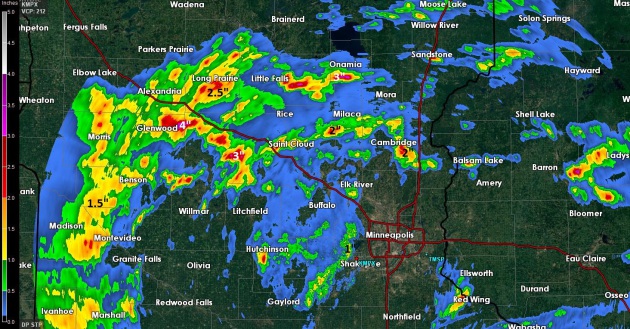
Rainfall Estimates as of 10 PM Monday. Much of the immediate Twin Cities metro missed out on rain yesterday, although the western suburbs saw some .5 to 1″ rainfall amounts, based on NWS Doppler estimates. As much as 2-3″ fell from near St. Cloud to Glenwood and Long Prairie, a band of very heavy rain over the far northern suburbs and Lake Mille Lacs area.
Tornado Damages Trailers at North Dakota man camp. At least 15 trailers associated with fracking in western North Dakota were severely damaged by a tornado late Monday. Details from The Washington Post.

84 Hour Future Radar. NOAA’s 12 km NAM model shows numerous showers and T-storms east of the Mississippi River; more showery rains from the Pacific Northwest into the northern Rockies. Dry weather prevails over the southwestern USA. Animation: HAMweather.
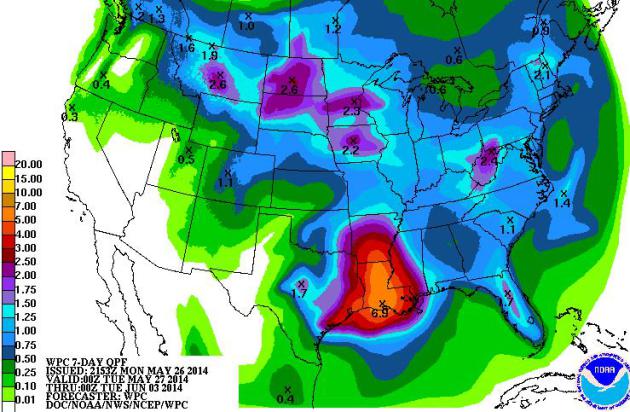
7-Day Rainfall Estimates. NOAA models show as much as 5-7″ of rain over the Lower Mississippi Valley, where widespread flash flooding is possible this week. Some 1-3″ amounts are possible from the Dakotas and Minnesota east to Pittsburgh.

Thursday at 4 PM. NAM guidance from NOAA shows highs topping 100F over the Dakotas by Thursday afternoon, summerlike heat expanding across the central USA, while the Pacific Northwest and Mid Atlantic region is stuck in the 60s. Map: HAMweather.
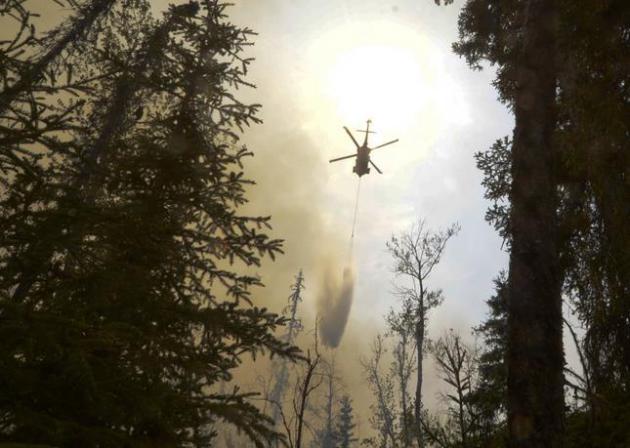
Alaska Wildfire is Bigger than Chicago. Newser has an update on the massive blaze; here’s an excerpt: “A huge fire burning in Alaska’s Kenai National Wildlife Refuge has exploded in size and now covers 243 square miles—an area bigger than the city of Chicago. The Funny River fire in the heavily forested reserve south of Anchorage is just 30% contained and authorities have ordered the evacuation of around 1,000 structures, the AP reports. The fire isn’t unusually big by Alaska standards, a state spokeswoman says, but it is occurring much earlier in the year than usual; unusually dry conditions, accompanied by high winds, are helping the blaze to spread…”
Photo credit above: “A helicopter dumps water on a portion of the Funny River Fire,Sunday, May 25, 2014, in the Funny River community in Soldotna, Alaska. The wildfire that has spread through the forest of Alaska’s Kenai Peninsula has expanded in size, prompting authorities to order the evacuation of 1,000 structures, officials said.” (AP Photo/Peninsula Clarion, Rashah McChesney).
* The blaze on Alaska’s Kenai Peninsula, south of Alaska, grew to 218 square miles as of late Monday. More details on the expanding Alaskan wildfire from The Star Tribune.
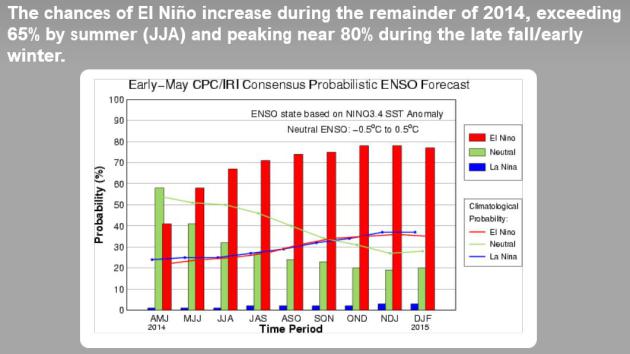
El Nino Update. The probability of going from ENSO-neutral to an El Nino warming phase in the Pacific rises to 65% this summer, peaking close to 80% by late fall and early winter. Details from NOAA CPC.

2014 El Nino Intensity Predictions. The consensus forecast calls for a roughly 1 C warming with the El Nino event underway. Most (but not all) El Ninos correspond with cooler, wetter weather over Minnesota and the Upper Midwest during the summer, but a bias toward drier, warmer weather during autumn and winter.
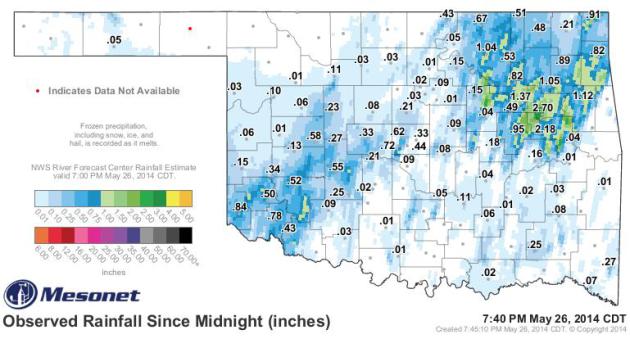
Oklahoma Mesonet, Celebrating It’s 20th Anniversary, Had It’s Roots in the 1984 Tulsa Flood. I didn’t realize this was the case, but major weather tragedies often spur new technologies and innovations. Here’s an excerpt from a story at Tulsa World: “…On May 26-27, 1984, a stalled cold front dumped six to 15 inches of rain on the Tulsa area, leaving 14 people dead and causing $180 million in damage. The storm took many in the area by surprise. From Tulsa’s tragedy came an idea to have information beyond just airport radar sites that were updated on an hourly basis, said Howard L. Johnson, retired associate state climatologist with the Oklahoma Climatological Survey…”
Map above: Oklahoma Climatological Survey and Mesonet.

Easing Your Child’s Fear of Severe Weather. KSTP-TV Meteorologist Jonathan Yuhas has some good advice and a helpful video for parents trying to help children respect the weather, without living in constant fear or paranoia, here’s an excerpt: “Jonathan suggests having a severe weather plan in place before the storm. “You’d want to have extra keys for your house and for your car, you’d want to have extra food for your kids and water for everyone as well,” Jonathan said. Also, he suggests having a cellphone and charger, cash, a credit card and a blanket. He also said talk to your kids about their fears. Jonathan suggests going to the library with them and reading a book or two about severe weather. “This offers a safe environment to teach your kids more about severe weather,” Jonathan said…”

MIT Finds New Way to Harvest Energy from Heat. Gizmag has the curious (and promising) details; here’s an excerpt: “Researchers at MIT and Stanford have found a new way to transform waste heat into electricity, particularly in situations where the temperature gradient is small, below 100º C (180° F). The technology uses widely available materials, and could be used to recycle the large amounts of wasted heat generated in industrial processes and electric power plants. According to the US Environment Protection Agency (EPA), one third of the industrial energy consumption in the United States is wasted as heat. If we could get even a small portion of it back, we’d be able to decrease power consumption significantly…”
File photo: Utah Geological Survey.

Solar Panels Drains The Sun’s Energy, Experts Say. I have a hunch this is parody. Well played, National Report. Here’s an excerpt of this important “scientific” breakthrough: “…Solar panels destroying the sun could potentially be the worst man-made climate disaster in the history of the world, and Halliburton will not be taking part in that,” the company stated in a press release issued Friday morning. “It’s obvious, based on the findings of this neutral scientific research group, that humans needs to become more dependent on fossil fuels like oil and coal, not less. Because these so-called `green technologies’ are far more dangerous to the Earth than any hydrofracking operation or deep-water drilling station. What good is clean air when our very sun is no longer functional?”

TODAY: Some sun, stray T-storm. Winds: SW 7. Dew point: 64. HIgh: 82
TUESDAY NIGHT: Evening thunder, then slow clearing. Low: 64
WEDNESDAY: Hazy sun, definitely feels like summer. High: 85
THURSDAY: Sticky sun, almost hot. Dew point: 63. Wake-up: 65. High: 87
FRIDAY: An early July. Still muggy. Dew point: 65. Wake-up: 66. High: 88
SATURDAY: AM sun, heavy PM T-storms likely. Wake-up: 68. High: 85
SUNDAY: Strong storms, some clearing late? Wake-up: 66. High: 81
MONDAY: Sunny, less humid. Dew point: 57. Wake-up: 61. High: 78
Climate Stories…

Climate Change Helping Hybridization Between Native, Invasive Trout Species: USGS Study. Implications for Minnesota’s lakes? Here’s an excerpt from Nature World News: “Researchers at the USGS along with colleagues at the University of Montana and Montana Fish, Wildlife & Parks found that change in temperature has accelerated hybridization between native westslope cutthroat trout and introduced rainbow trout. Experts have predicted that warmer temperatures will help invasive fish grow and form hybrids with native fish. The study is published in the journal Nature Climate Change…”

Hoping for a Rational Climate Change Discussion. Here’s a line of reasoning that made perfectly good sense to me, in a story at Energy Trends Insider. Here is a clip: “…My position is that I hope those on the side of “little impact” are correct, but we need to plan and prepare to the greatest extent possible for the possibility that they are not. One of the things I do professionally is risk assessment and mitigation. In fact, we all do it to some extent. For example, we may believe that the probability that our homes will burn down is low, but the consequences are so severe in the event that it happens that we pay for homeowner’s insurance. So for low risk but high consequence events, we have insurance. Even if you don’t believe future climate model projections, would you concede that there is a chance you are wrong? Do you think there is a 1 percent chance you are wrong? Do we have planetary insurance in the event you are wrong?...”


GOP In Grip of Climate Change Denial. No kidding, in fact some wear it as a badge of honor. Let’s ignore the science, data and facts, and make up our own competing narrative, one that won’t bite the hand that feeds. Here’s a clip from an Op-Ed at Rutland Herald Online: “…Now just why is it that nearly every Republican presidential wannabe has decided that climate change is not real? It is very hard not to conclude it’s all about the money. Since the Supreme Court opened the floodgates to virtually unlimited campaign contributions, often secretly donated, significantly more than a billion dollars will be needed to get elected president in 2016. And Republican candidates expect to receive much of their money from the oil, gas and coal industries — who by curious coincidence, just don’t happen to recognize climate change either…” (Image above: NASA).
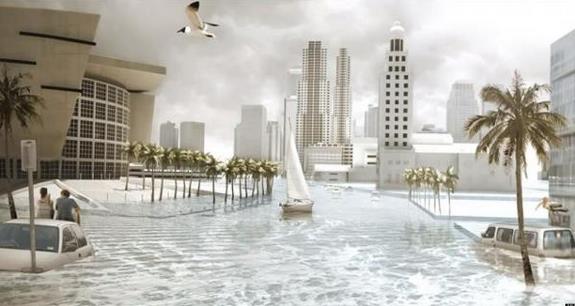
University of Miami Geologist in Trenches of Climate Change. The implications of rising seas are especially bleak for southern Florida, where denial is rapidly giving way to action. Here’s an excerpt from a story at The Miami Herald: “…But Wanless contends that softening predictions is irresponsible. In typical fashion, his warning comes in stark terms. “The truth is out now. Our tenure on low-lying parts of South Florida is coming to an end. You buy down here at your own peril,” he said. “If communities and governments aren’t fairly warning people, they are at massive risks for lawsuits because the reality is here.”
* graphic above: Florida Center for Environmental Studies. Featured in an article at WLRN, “Why Handwringing about Sea Level Rise Won’t Save Miami.”
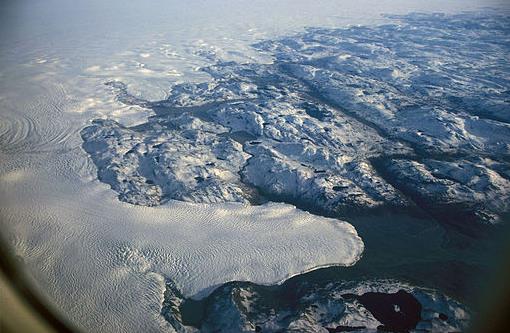
Greenland Ice May Melt Even Faster. Watch for more “unknown unknowns”, otherwise known as tipping points. Satellite and radar data is discovering what’s really going on beneath Greenland’s rapidly melting ice sheet. Here’s a clip from a story at Climate News Network and truthdig.com: “Just days after US researchers identified geophysical reasons why West Antarctica’s glaciers are increasingly vulnerable to global warming, a partner team has pinpointed a related cause for alarm in Greenland. Many of the bedrock crevices and canyons down which the island’s glaciers flow have basements that are below sea level. This means that as warm Atlantic waters hit the glacier fronts, the glaciers themselves become more vulnerable to global warming and increasingly likely to melt at a faster rate…”
Photo credit above: “Melting away: an aerial view of the margin of Greenland’s threatened ice sheet.” Photo by Hannes Grobe/Alfred Wegener Institute via Wikimedia Commons.
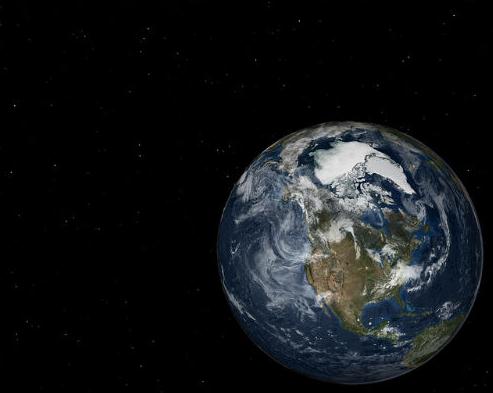
Who Are The “Alarmists” Here? Real Conservatives Value Evidence. Barry Bickmore presents his argument at Utah’s Deseret News; here’s an excerpt that caught my eye: “…So who is being “hysterical” and “alarmist?” On one hand, we have people using all the best scientific, political and economic analyses — complete with estimates of uncertainty and risk — to come up with recommendations on how to solve a pressing problem in the most cost-effective manner. On the other hand, we have self-proclaimed “conservatives,” supposed champions of personal responsibility, neglecting to obtain even a cursory familiarity with the best scholarship on the topic, blaming our inaction on what they assume (without evidence) China will do, extolling the unlimited capacity of humans to solve problems while excusing the present generation from even trying, and shrieking overwrought, nonsensical warnings about what serious climate action will cost…”
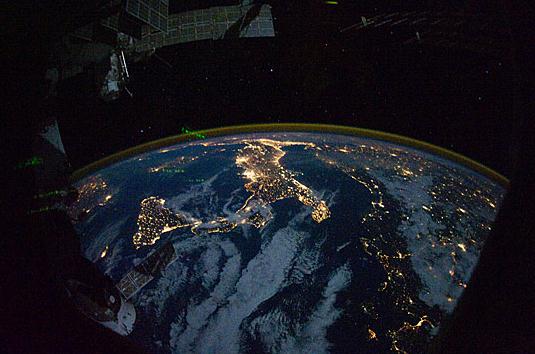
Thomas Friedman: Climate Change Needs Urgent Action. Should future generations get a vote….today? Here’s a clip from an Op-Ed at Times Union: “…Even if we can’t know what future citizens will actually value and believe in, we can still consider their interests, on the reasonable assumption that they will somewhat resemble our own (everybody needs breathable air, for example),” wrote Wells in Aeon Magazine. Since “our ethical values point one way, towards intergenerational responsibility, but our political system points another, towards the short-term horizon of the next election,” we “should consider introducing agents who can vote in a far-seeing and impartial way…” (Image: NASA).


